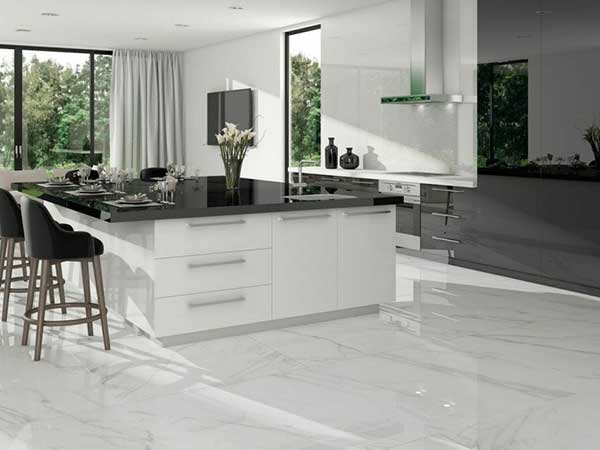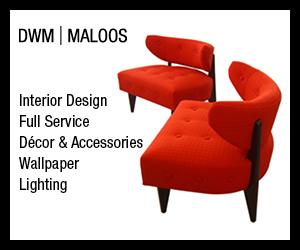Is there any floor more important than your kitchen floor?
A few years ago I remodeled the kitchen and had a tough time deciding on what flooring to use. Durability and style were the top considerations – but there were so many other things.
Not only are there aesthetic considerations, but I want it to tie in with the new cabinets, and countertops, and at least attempt to choose something durable and able to withstand 3 kids walking on it (and spilling on it) all day long. I also wanted it to have some continuity with the rest of my homes flooring. And, what about comfort? Your legs won’t feel the best after spending hours standing on a rock hard floor.
One thing I didn’t want was traditional hardwood flooring. However, hardwood flooring is the trend right now. Everyone wants wood floors in the kitchen this year. Not necessarily real wood, but at least wood looking floors. That could be hardwood, luxury vinyl, laminate, or even wood look tile. I did want to choose something that added resale value.
But, with a thousand choices my primary issue was durability. Your kitchen floor must be extremely durable. It’s also important to make sure your floor isn’t sensitive to spills, water, stains, etc. Kitchens are supposed to get messy, and they are – especially with kids.
In 2020, you’ll see lots of trendy kitchens that are practical as well. There are so many options these days. You don’t have to choose between just hardwood and tile. So what types of flooring are best for kitchens and why? Those are the exact questions we are going to answer here.
With endless options comes endless opportunity for creativity. Let’s take a look at some of the best flooring options for a kitchen and see how they measure up.
Kitchen Flooring Types
Wood floors are the most popular right now, but it’s critical to find flooring for the kitchen that’s low maintenance. Traditional wood flooring looks great, and can be durable, but is sensitive to spills and drops. And, with so many other options the trend is opting for the most low maintenance choices.
Waterproof Vinyl Kitchen Flooring
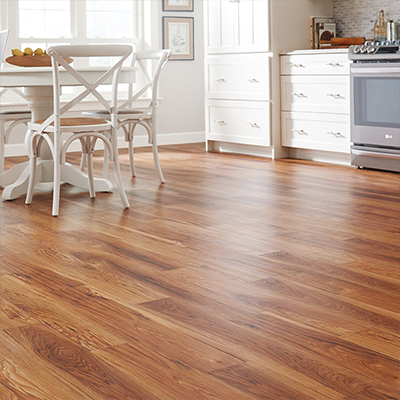
Don’t turn up your nose. Vinyl flooring is looking better, and the options are virtually endless.
Luxury vinyl planks and tiles can mimic the look of real wood and natural stone. Vinyl sheets can also look like stone, wood, or other styles. Not only is luxury vinyl flooring durable, all vinyl is water-resistant and you can even find choices that are waterproof.
Another bonus with vinyl is that it is relatively soft. If you spend a few hours on your feet in the kitchen on very hard floors you can feel it. This is a huge plus for some folks.
The value is there, since it costs less. However, despite all these benefits installing vinyl does not add to the resale value of your home. That’s something to think about if you plan on selling in the short term.
Pros:
- Budget-Friendly flooring
- Vinyl is water-resistant and some options are waterproof
- Low maintenance
- A wide assortment of colors and styles
Cons:
- Does not add value to the home
- It is not eco-friendly
- Vinyl is susceptible to scratches and gouges
Recently WPC Vinyl Flooring is the trend.
WPC vinyl flooring, which stands for wood plastic composite, is an engineered, luxury vinyl plank flooring newly introduced into the market. The engineered backing combines recycled wood pulp and plastic composites to form a bond of strength and stability.
Expect to see WPC vinyl floors following all the hottest wood trends, including handscraped and distressed looks, large planks and more.
WPC vinyl floors are the fastest growing floors on market, particularly in kitchens, bathrooms and other water-prone areas. The looks will only get more convincing and, eventually, people will recognize modern vinyl as a fantastic wood alternative and forget the dated vinyl floors from the 1970s.
Porcelain Tile Kitchen Flooring

Tile is known for being durable and easy to clean, perfect for kitchens. Porcelain tile in particular is extremely durable. You can’t find a tougher material to put in your kitchen.
Pros:
- Hard and durable.
- Porcelain is extremely stain-resistant.
- It is a truly waterproof option.
- It can look like natural stone, yet is much less expensive.
Cons:
- Hard material makes it difficult to stand on for long periods of time
- Slippery surface when wet
- Installation best completed by a professional
When it is made, porcelain is fired at very high temperatures. These high temperatures create a tile that is extremely hard, very durable, and one that water cannot penetrate. So, for durability porcelain tile flooring is top of the mark.
But, porcelain tile in the kitchen does have serious downsides.
First, because these tiles are so hard, you might get tired standing on them for long periods of time. While this may not be a problem for folks who don’t spend much time in the kitchen, there are hobbyists who spend a ton of time on their feet in the kitchen baking or cooking. So it’s advisable to wear comfortable shoes, or buy a floor mat.
Second, while your tiles are incredibly durable and waterproof, the same is not always true of your grout. I found this to be an occasional problem with my kitchen tile. Wine, or other acidic juices can stain the grout.
To get around the grout problem it’s best to install the tile with a minimal grout line. Don’t let your tile setter use spacers that create more space than a quarter will slide into. Also, properly seal the floor after the grout has dried and once a year afterward. For this and other reasons it’s best to have porcelain tile floors installed by a professional – which adds costs.
The wood look tile kitchen flooring trend is super-hot right now. Tile manufacturers are keeping up with the times and following the trends of contemporary wood and stone. Look for them in most tile stores or in our tile flooring section. Tile kitchen floors are timeless, and always a great option.
Laminate Kitchen Flooring
Laminate is one of the most popular wood-look flooring. Before laminate flooring was added to the kitchen it was generally real hardwood, or vinyl. But, is laminate flooring a good idea for your kitchen floor? Not so much.
Laminate flooring generally does not hold up well under moist conditions – good with traffic but not moisture. Even a small spill can cause serious staining and warping.
Manufacturers are starting to produce water-resistant laminate flooring using similar techniques as for engineered hardwood. But it is still relatively expensive. In the meantime, until technology develops, if you are looking for wood flooring that will hold up in the kitchen, you are probably better off investing in engineered hardwood, which is also water-resistant and adds greater value to your home.
So, will laminate kitchen floors be a trend in the future? Not likely with so many other options. Laminates will continue to do well throughout the rest of the house – and is one of my favorites for sure. But, at the moment not the best option for the kitchen.
Engineered Wood Kitchen Flooring
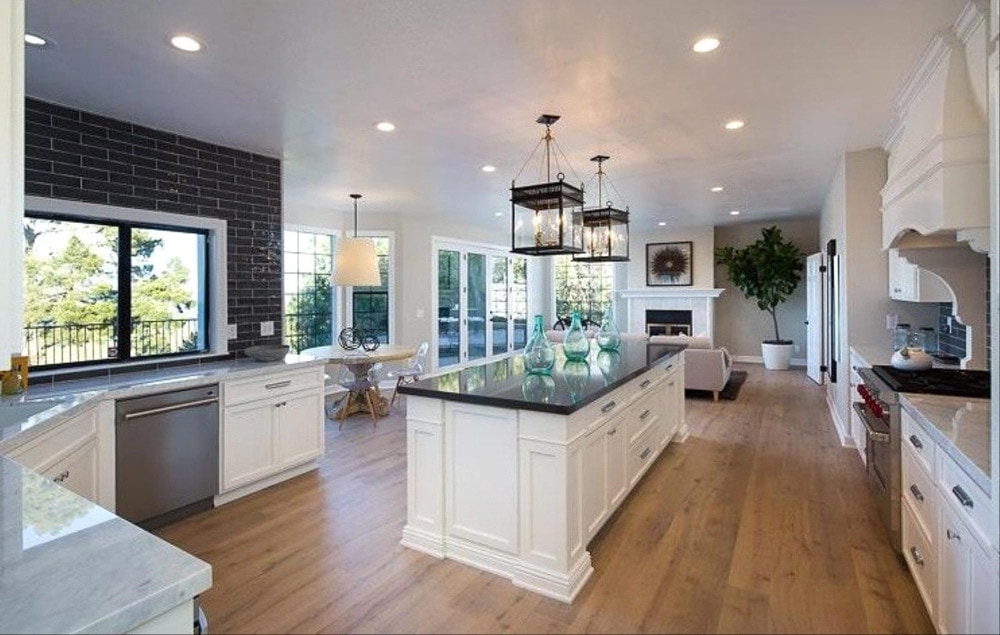
Pros:
- Durable enough to withstand traffic
- Moisture-resistant enough to handle kitchen spills
- Hardwood flooring increases your home value
- Can be cushioned underneath
- Can be used to tie in with other areas of the home
Cons:
- One of the more expensive options for kitchens
- Difficult to repair damage
- Many times not VOC free
In the past, many people avoided using hardwood flooring because of the moisture and heat often created in the kitchen. Solid hardwood can expand and warp in humid and moist environments. However, engineered hardwood is extremely durable and will expand or contract with heat and moisture without damage.
This flooring can also withstand high amounts of traffic and the messes that come along with them. Regular sweeping and mopping are all you need to keep these floors in good shape. And since they are moisture-resistant, if anything spills on them while you are cooking, simply wipe it up. It won’t damage engineered hardwood.
Another reason why this is such a great choice for kitchen flooring is how well it transitions to other rooms. If you have an open-concept floor plan, you can use the same flooring from room to room.
Engineered wood flooring feature a veneer top layer of solid wood; however, the remaining base of the product is made up of man-made materials. This base could be composed of plywood or high-density fiberboard. The way it’s constructed make it easier to install, and can also be refinished at least once.
To have a real wood floor in your kitchen, engineered wood is the way to go. It’s less inclined to warp, or shift, and better suited to stand up to the high traffic in your kitchen.
Cork Kitchen Flooring
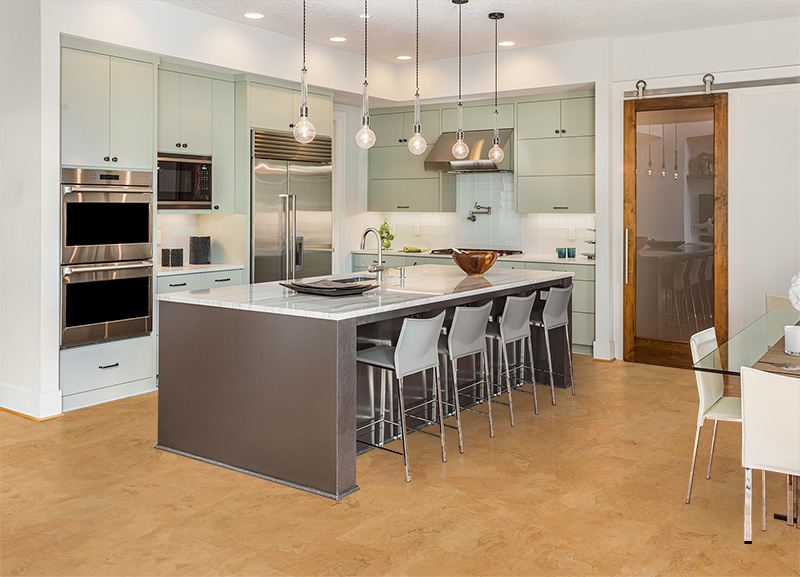
Pros:
- Eco-friendly
- Softer material for standing on all day
- Moisture and slip-resistant
Cons:
- Must be re-sealed every 3-4 years
- Sun will discolor cork flooring
- Prone to indentations from heavy objects
Cork flooring has become a popular flooring option in homes, is easy to clean, and is one of the best floorings for kitchens. It is also one of the most sustainable flooring products you will find. Cork is harvested from tree bark.
Cork is both soft and safe to walk on. It is soft to touch and has a textured surface that helps prevent you from slipping on it. It is also kind on your joints if you spend a lot of time on your feet in the kitchen. A real cook might spend the entire day in the kitchen making preserves, baking, or preparing food for a large number of people. Try that on a hard tile or natural stone surface? Ouch!
But, if you choose cork flooring for your kitchen (or anywhere else in the house) keep the blinds closed. It’s prone to fading.
Overall, if you’re looking for an environmentally friendly choice cork is the one. Not only that, but styles have improved and there are now some great looking cork floors. As a trend in the kitchen – only time will tell. I’d say it’s a style that will possibly fade if engineered wood floors continue to improve and become more environmentally safe.
Natural Stone Tile Flooring
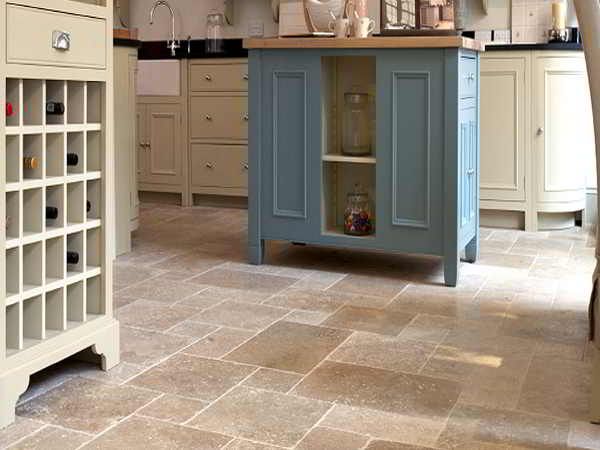
Pros:
- Top quality look and design
- Wide variety of styles and colors
- Adds resale value to your home
- Very durable
Cons:
- Expensive option
- Difficult to install
- Some types of stone are vulnerable to damage
Natural stone is the best alternative to hardwood flooring for your kitchen if you want to add resale value to your home. It comes in many beautiful options. Most common types are travertine, slate, and marble, but there are many others.
Natural stone tile flooring is waterproof and extremely durable, but not as durable as porcelain tile. As with all tile, you need to make sure to seal it periodically to protect it. However, with natural stone it’s especially important since it’s sometimes more porous.
If you have the budget natural stone can be the most impressive, beautiful choices and add great value to your home. Not all the cost is with the stone. With their weight, and other complexities, it’s best to have a professional installation.
As far as trends in the future, you’ll likely see natural stone in the kitchen a long time. Most types are timeless, durable, and elegant.
Price Comparison
Now that you know what your best kitchen flooring options are, how do you decide on one? One big consideration is cost.
Your actual cost will depend on several issues such as where you live, the size of your kitchen, and how difficult the installation will be. Keep in mind the installation usually costs the same, or more, than the materials. So, general rule of thumb is to go as big as you can since it’s only part of the costs.
Here is a general estimate of the average cost of materials for a 250-Square-Foot Kitchen:
- Cork Flooring: $1,600
- Engineered Hardwood: $2,600
- Vinyl Flooring: $500 for sheet vinyl, $1,200 for luxury vinyl
- Porcelain Tile Flooring: $1,275
- Natural Stone Tile Flooring: $2,300
Installing A Kitchen Floor
Installation is another factor when choosing the best kitchen flooring for your home. Some of the options are a good DIY project, but others usually require significant skills and tools to install. But, as an installer myself I will tell you there is only a marginal amount of difference of installation costs for kitchen floors – natural stone being an exception.
Cork, engineered hardwood, and vinyl flooring are all relatively easy to install yourself. So, that can save a ton of money. These are what they call “floating floors”, which means they should not be installed underneath your cabinets, as the weight of the cabinets can inhibit their natural expansion and contraction.
If you decide to hire a professional installer to do the job, expect to pay installation fees around $6 a square foot for cork, $8 a square foot for engineered hardwood, $3 a square foot for sheet vinyl, and $7 a square foot for vinyl tile and plank. Porcelain tile is anywhere from $9-$12 a square foot, and natural stone is from $9-$15 square foot depending on the size and type.
Overall there are few variances with cork, engineered wood, and vinyl. However, with tile and stone there are many choices with patterns, and grout types, that can increase labor costs. I always recommend having the tile setter use thin grout lines in the kitchen. I also prefer a diagonal pattern to the room (just a style preference). Check the web or magazines to see what you prefer and show the installer before beginning.
What Is The Most Durable Flooring For The Kitchen?
Porcelain tile is the most durable flooring for your kitchen. The way it is manufactured means it is waterproof, and it is highly scratch-resistant. You are very unlikely to scratch tile flooring with your shoes, and your pet is unlikely to scratch it with their nails.
Tile is my favorite choice for kitchens, because of the durability. However, careful with cleanup – staying away from harsh chemicals. Water or vinegar are usually fine. And, remember to keep them sealed.
What Is The Easiest Kitchen Floor To Keep Clean?
Tile is one of the easiest floors to keep clean in any situation, including in the kitchen. Tiles do not soak up dirt, so it is easy to remove by sweeping. For a deeper clean, detergent is not even required—warm water or steam can be enough to do the job.
But, while tiles are easy to keep clean on a day-to-day basis, the grout that holds them in place is more complicated, and it is often the first thing to start to look grubby. Unlike with the tile, dirt and moisture can soak into the grout, leading to mold and discoloration.
Seal grout upon installation and every few years to protect it from soaking up moisture, and clean your grout periodically using baking soda or a specialist grout cleaner.
Is Vinyl Plank Flooring Good For Kitchens?
Vinyl plank flooring is an excellent choice for kitchen. It is waterproof and deals well with changing temperatures, so it won’t buckle and warp in kitchen conditions. It’s also scratch and dent resistant, so it is unlikely to get scuffed up by heavy foot traffic – which is why many retail stores use it on their floors. It’s also a great DIY project since it’s relatively easy to install.
Should Kitchen Flooring Go Under Cabinets?
This is a common question, but it depends on the type of flooring being installed. For any flooring that adheres to the floor, such as tile, and perhaps engineered hardwood depending on the type you choose, the flooring should go under the cabinets, forming a solid base for the entire kitchen.
However, if you are installing floating floors that do not adhere to the ground, such as vinyl plank flooring or some engineered hardwoods, they should be installed after your cabinets are in. This is because the weight of the cabinets can restrict the floor from its natural expansion and contraction.
Top Kitchen Floor Trends
Wood-look porcelain tile
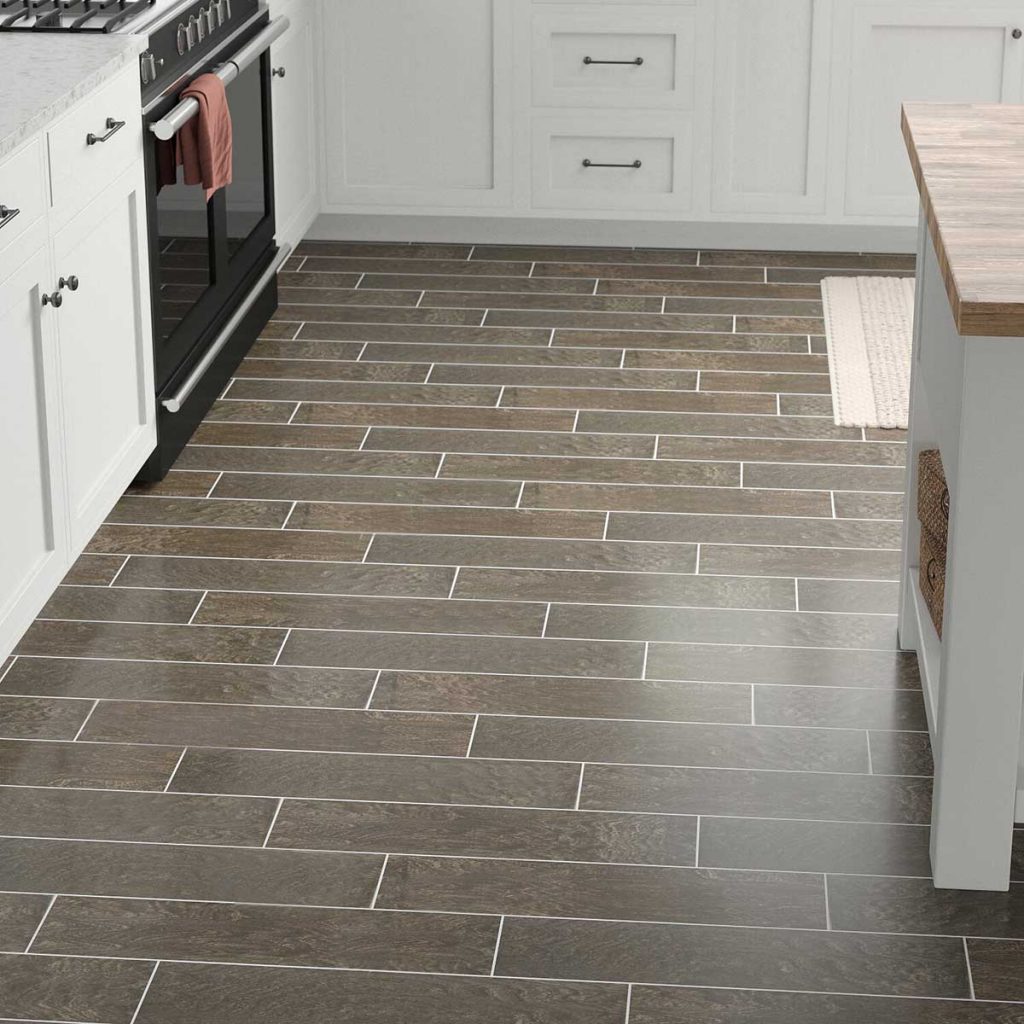
With wood, and any natural look, being the trend in every room it follows that wood-look tile would become popular. And, with such wonderful styles and variances to choose from it’s one of the top choices this year. Some will even fool you at first glance. The look of wood with the durability of porcelain!
Waterproof vinyl plank flooring

Like laminate, vinyl can have a wood look and is comparable in price, but it’s much more durable. And since it’s water-resistant, it can be installed in kitchens and bathrooms. The manufactured vinyl styles are so beautiful that it’s not a plastic look anymore. Not to mention the commercial grade vinyl that lasts forever. It’s definitely something to check out.
Stained concrete

Stained concrete is a modern, industrial look that even has a natural tone depending on how it’s polished. Installation is key, as it’s a special mix of high-grade concrete that makes the finish fabulous. Also, if you’re looking for the best stain it’s difficult to find in states like California who do not allow the sale of chemical stains that are longer lasting. However, if you have a pro who knows their stuff this is a great look that is very durable. High on the durability scale, low on the comfort, but very stylish and a great variety of options.
Terrazzo
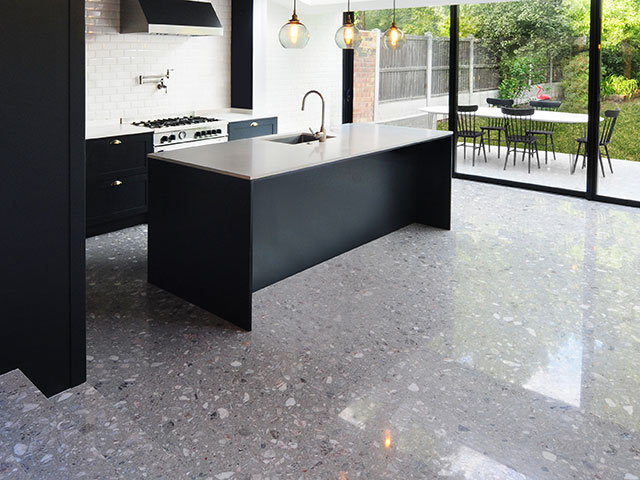
Terrazzo is made from stone fragments, crushed glass, shells or other organic materials embedded in concrete and polished until smooth. It is best used in large format flooring in mid-century modern homes. It’s also an environmentally friendly product. However, the cost is usually high – about $5k+ for a 250 square foot kitchen.
Large-format and special pattern tiles

No longer content with 12” square tiles placed square to the walls, we’re now seeing more demand for much larger tile sizes and patterns that are varied in the room. My kitchen has 24” tiles set diagonal to the room. Remember – larger tiles means fewer grouts and less to clean.


